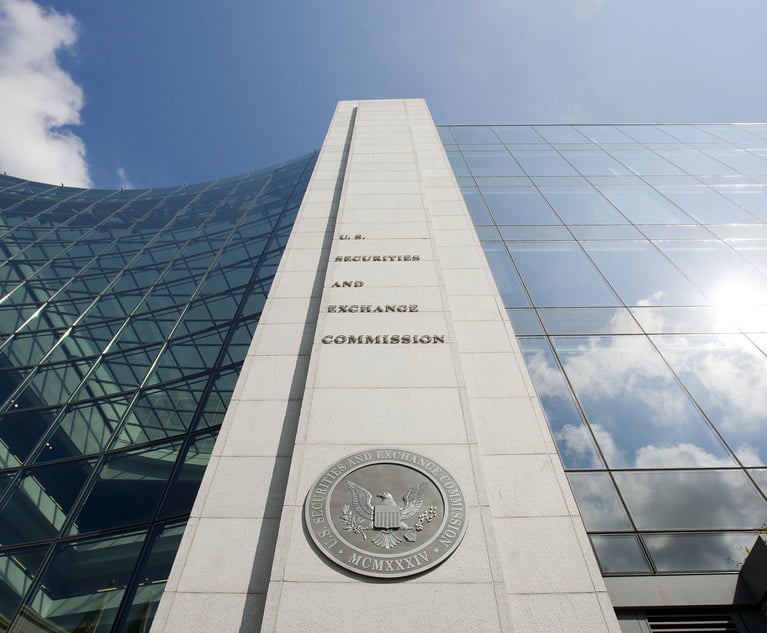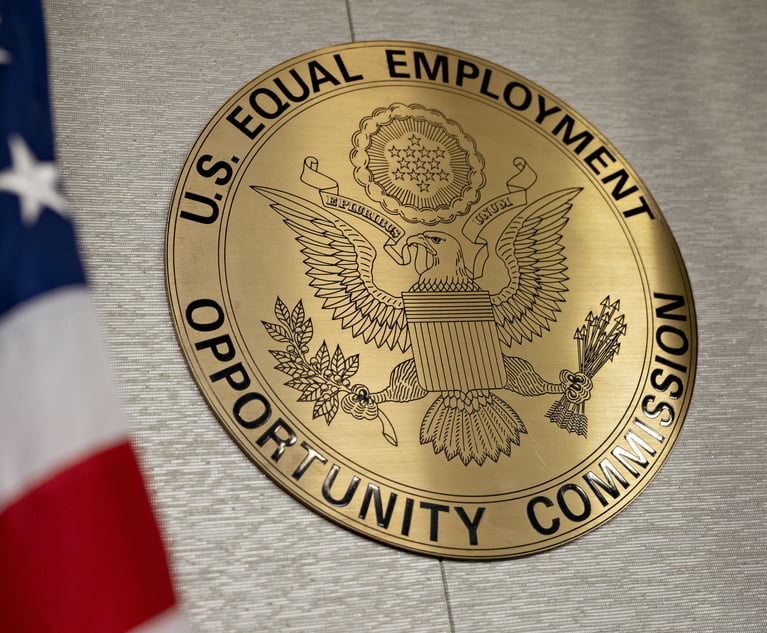Litigation: Two approaches to objectively evaluating the effectiveness of outside counsel
Since the early 1990s, my firm has worked on a multitude of cases addressing issues relating to litigation management, the necessity and reasonableness of attorneys fees and the ethics of hourly billing.
June 13, 2013 at 05:15 AM
6 minute read
The original version of this story was published on Law.com
Since the early 1990's, my firm has worked on a multitude of cases addressing issues relating to litigation management, the necessity and reasonableness of attorneys' fees and the ethics of hourly billing. Two critical tools in our litigation management arsenal are what we refer to as the Phase I and Phase II audits. We also frequently employ a “hybrid” of the two approaches, which is also designed to measure the reasonableness of fees and costs.
The “Phase I Approach” —Quantity, Structure and Form
The Phase I approach focuses on the amount and the components of time that a law firm has billed to the client. This approach is designed to determine whether attorneys and other professionals have complied with generally accepted billing practices as well as the applicable billing guidelines. The analysis frequently results in recommendations for deductions for activities that fail to comply with industry norms.
The Phase I approach focuses on metrics of compliance and efficiency. Thus, it is important to establish reliable, straightforward protocols before undertaking such an evaluation. These might include determining the minimum time increment used to warrant deducting an inappropriate billing entry.
The practice of “block billing,” also known as “bulk billing” or “aggregate billing,” is often an area of major concern identified in Phase I analysis. “Block billing” is the practice of combining two or more tasks into a single billing entry. The author does not allocate time between the tasks and states a single total amount of time for all tasks contained within the blocks. Confronted with time that is block billed, the client or feepaying third party is effectively prevented from making a meaningful determination of the time actually spent on any of the individual tasks listed in the block.
Vague entries also may be problematic. Courts require precision in evaluating the reasonableness of fees billed by counsel. We typically express concern and flag for discussion “vague” entries where the description makes it difficult to determine the nature and/or scope of services actually performed.
Billing by attorneys and paralegals for “clerical” or “secretarial” tasks is also inappropriate. These activities are generally considered part of a law firm's overhead expenses, which already are factored into the firm's hourly rates for professional services. Similarly, nonsubstantive, computerrelated and database charges should not appear on an invoice at professional rates.
The Phase I approach also analyzes the fronted costs and expenses. At a minimum, in-house counsel should always require backup documentation, above a certain threshold, for the costs incurred. As with attorneys' fees, the test for evaluating disbursements is that of reasonableness and necessity. General overhead expenses are not appropriate to bill to the client as the rules of ethics state that such charges should be factored into the attorneys' hourly billing rates. Items of elite or conspicuous consumption, such as firstclass airline travel, luxury meals, expensive wine or personal items may also be inappropriate.
The Phase I approach also frequently reveals unapproved billing rate increases, incorrect math, or even invoices or tasks charged to the wrong matter. Items such as these should of course be deducted off the top.
The Phase II Analysis—Substantive Review and Analysis of the Bills and Work Product
The Phase II analysis is designed to question and validate the overall strategic approach implemented by the law firm in the litigation. When we conduct this analysis, we focus on a comprehensive analysis of the work product, including the case docket, correspondence, emails, discovery requests and ediscovery materials as well as critical motions, status conference statements and other pleadings. This is the appropriate starting point as an analysis of the work product juxtaposed with the billing entries frequently results in the identification of wasteful practices, duplicative staffing and questionable strategic decisions.
A key barometer of law firm performance is how the law firm handles discovery, particularly ediscovery issues. A firm's ability to quickly sift through vast quantities of documents, particularly in sensitive special investigations, is a key performance benchmark. In government investigations, this is particularly important as counsel must interface and cooperate with numerous agencies and rapidly produce the documents requested, but at all times thoroughly protect necessary confidences and applicable privileges. In these situations, the client is relying on counsel to quickly find the facts and key documents that prove or disprove core allegations and expeditiously stabilize the situation.
When evaluating a firm's ediscovery capabilities, the Phase II approach analyzes the following:
- The type and capabilities of the consultants and/or experts retained by the law firm to assist in the initial document retrieval and analysis
- The timeliness and accuracy of the document review effort
- The initial search directives as well as modifications to the case strategy. With the correct vendor and strategy in place, a search logic can often be applied across the entire document collection, providing outstanding leverage
- How the law firm handles tricky issues of confidentiality and its effectiveness in responding to agency inquiries
Optimally, the Phase II review is focused on objectively evaluating the quality of the law firm's work. This resultsoriented approach looks to factors including the case's ultimate disposition. It asks whether the client could reasonably have achieved a more beneficial result for less money and the value achieved for the client.
Where the Phase I approach can be fairly categorized as an “overview” of the bills, the Phase II analysis examines each entry, in its greater substantive context, if necessary, simultaneously across multiple firms and billers. The approach analyzes for examples of efficiency as well as irregularities and wasteful practices.
Conclusion
The Phase I and Phase II reviews are different tools that can be applied depending on the desired goals and objectives. Where significant issues or problems are identified in the Phase I analysis, this can point to larger problems of efficiency indicating that a more thorough analysis may be in order. A hybrid of the two approaches is also possible. The two approaches combined efficiently assess and correct the quality of service, often resulting in maximum value for a company.
This content has been archived. It is available through our partners, LexisNexis® and Bloomberg Law.
To view this content, please continue to their sites.
Not a Lexis Subscriber?
Subscribe Now
Not a Bloomberg Law Subscriber?
Subscribe Now
NOT FOR REPRINT
© 2025 ALM Global, LLC, All Rights Reserved. Request academic re-use from www.copyright.com. All other uses, submit a request to [email protected]. For more information visit Asset & Logo Licensing.
You Might Like
View All

Trending Stories
- 1Uber Files RICO Suit Against Plaintiff-Side Firms Alleging Fraudulent Injury Claims
- 2The Law Firm Disrupted: Scrutinizing the Elephant More Than the Mouse
- 3Inherent Diminished Value Damages Unavailable to 3rd-Party Claimants, Court Says
- 4Pa. Defense Firm Sued by Client Over Ex-Eagles Player's $43.5M Med Mal Win
- 5Losses Mount at Morris Manning, but Departing Ex-Chair Stays Bullish About His Old Firm's Future
Who Got The Work
J. Brugh Lower of Gibbons has entered an appearance for industrial equipment supplier Devco Corporation in a pending trademark infringement lawsuit. The suit, accusing the defendant of selling knock-off Graco products, was filed Dec. 18 in New Jersey District Court by Rivkin Radler on behalf of Graco Inc. and Graco Minnesota. The case, assigned to U.S. District Judge Zahid N. Quraishi, is 3:24-cv-11294, Graco Inc. et al v. Devco Corporation.
Who Got The Work
Rebecca Maller-Stein and Kent A. Yalowitz of Arnold & Porter Kaye Scholer have entered their appearances for Hanaco Venture Capital and its executives, Lior Prosor and David Frankel, in a pending securities lawsuit. The action, filed on Dec. 24 in New York Southern District Court by Zell, Aron & Co. on behalf of Goldeneye Advisors, accuses the defendants of negligently and fraudulently managing the plaintiff's $1 million investment. The case, assigned to U.S. District Judge Vernon S. Broderick, is 1:24-cv-09918, Goldeneye Advisors, LLC v. Hanaco Venture Capital, Ltd. et al.
Who Got The Work
Attorneys from A&O Shearman has stepped in as defense counsel for Toronto-Dominion Bank and other defendants in a pending securities class action. The suit, filed Dec. 11 in New York Southern District Court by Bleichmar Fonti & Auld, accuses the defendants of concealing the bank's 'pervasive' deficiencies in regards to its compliance with the Bank Secrecy Act and the quality of its anti-money laundering controls. The case, assigned to U.S. District Judge Arun Subramanian, is 1:24-cv-09445, Gonzalez v. The Toronto-Dominion Bank et al.
Who Got The Work
Crown Castle International, a Pennsylvania company providing shared communications infrastructure, has turned to Luke D. Wolf of Gordon Rees Scully Mansukhani to fend off a pending breach-of-contract lawsuit. The court action, filed Nov. 25 in Michigan Eastern District Court by Hooper Hathaway PC on behalf of The Town Residences LLC, accuses Crown Castle of failing to transfer approximately $30,000 in utility payments from T-Mobile in breach of a roof-top lease and assignment agreement. The case, assigned to U.S. District Judge Susan K. Declercq, is 2:24-cv-13131, The Town Residences LLC v. T-Mobile US, Inc. et al.
Who Got The Work
Wilfred P. Coronato and Daniel M. Schwartz of McCarter & English have stepped in as defense counsel to Electrolux Home Products Inc. in a pending product liability lawsuit. The court action, filed Nov. 26 in New York Eastern District Court by Poulos Lopiccolo PC and Nagel Rice LLP on behalf of David Stern, alleges that the defendant's refrigerators’ drawers and shelving repeatedly break and fall apart within months after purchase. The case, assigned to U.S. District Judge Joan M. Azrack, is 2:24-cv-08204, Stern v. Electrolux Home Products, Inc.
Featured Firms
Law Offices of Gary Martin Hays & Associates, P.C.
(470) 294-1674
Law Offices of Mark E. Salomone
(857) 444-6468
Smith & Hassler
(713) 739-1250







